-
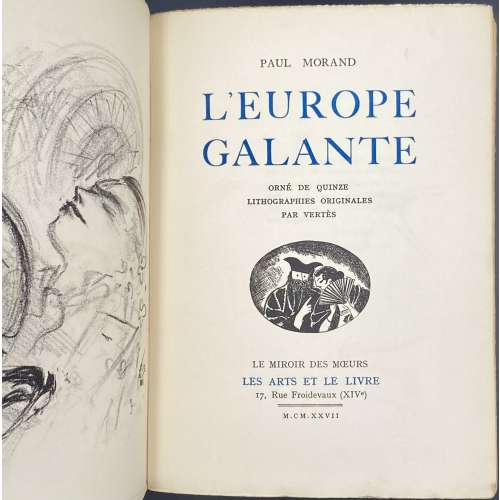 Front wrapper (in black and blue): PAUL MORAND | L'EUROPE | GALANTE | QUINZE LITHOGRAPHES | HORS TEXTE ORIGINALES | DE VERTÈS | {vignette} | LE MIROIR DES MŒURS | LES ARTS ET LE LIVRE | =| M. CM. XXVII || Title-page (in black and blue): PAUL MORAND | L'EUROPE | GALANTE | ORNÉ DE QUINZE | LITHOGRAPHES ORIGINALES | PAR VERTÈS | {vignette} | LE MIROIR DES MŒURS | LES ARTS ET LE LIVRE | 17 Rue Froidevaux (XIVe) | =| M. CM. XXVII || Pagination: [1-9] 10-245 [7], and 2 leaves under the wrappers, ils. Collation: 8vo; [1]8 2-168; first and last leaves under wrappers; total 128 leaves and 17 plates extraneous to collation (two more than the declared 15). Binding: 20.5 x 14.5, French flapped tan wrappers with lettering and vignette, lettering to spine. Printed on May 30, 1927 at l'Imprimerie du Livre, Rueil (Henri Filipacchi, director); under supervision of Georges-Célestin Crès. Edition: 3rd book is the series "Le miroir des mœurs", limited to 1165 copies of which 65 on Papier d'Annam, 15 of them not for sale, numbered 1-50 and 51-65, respectively; 1100 copies on Vélin teinté de Rives (100 of them not for sale), numbered 66-1065 and 1066-1165, respectively. This copy is № 474. Contributors: Paul Morand (French, 1888 – 1976) – author. Marcel Vertès [Marcell Vértes] (Jewish-Hungarian-French, 1895 – 1961) – artist. Les arts et le livre; Georges-Célestin Crès (French, 1875 – 1935) – publisher. l'Imprimerie du Livre (Rueil); Henri Élie Michel Filipacchi [Flippaki] (French, 1900 – 1961) – printer. Other names: Marcel Vertès, Marcel Vertes, Marcell Vértes
Front wrapper (in black and blue): PAUL MORAND | L'EUROPE | GALANTE | QUINZE LITHOGRAPHES | HORS TEXTE ORIGINALES | DE VERTÈS | {vignette} | LE MIROIR DES MŒURS | LES ARTS ET LE LIVRE | =| M. CM. XXVII || Title-page (in black and blue): PAUL MORAND | L'EUROPE | GALANTE | ORNÉ DE QUINZE | LITHOGRAPHES ORIGINALES | PAR VERTÈS | {vignette} | LE MIROIR DES MŒURS | LES ARTS ET LE LIVRE | 17 Rue Froidevaux (XIVe) | =| M. CM. XXVII || Pagination: [1-9] 10-245 [7], and 2 leaves under the wrappers, ils. Collation: 8vo; [1]8 2-168; first and last leaves under wrappers; total 128 leaves and 17 plates extraneous to collation (two more than the declared 15). Binding: 20.5 x 14.5, French flapped tan wrappers with lettering and vignette, lettering to spine. Printed on May 30, 1927 at l'Imprimerie du Livre, Rueil (Henri Filipacchi, director); under supervision of Georges-Célestin Crès. Edition: 3rd book is the series "Le miroir des mœurs", limited to 1165 copies of which 65 on Papier d'Annam, 15 of them not for sale, numbered 1-50 and 51-65, respectively; 1100 copies on Vélin teinté de Rives (100 of them not for sale), numbered 66-1065 and 1066-1165, respectively. This copy is № 474. Contributors: Paul Morand (French, 1888 – 1976) – author. Marcel Vertès [Marcell Vértes] (Jewish-Hungarian-French, 1895 – 1961) – artist. Les arts et le livre; Georges-Célestin Crès (French, 1875 – 1935) – publisher. l'Imprimerie du Livre (Rueil); Henri Élie Michel Filipacchi [Flippaki] (French, 1900 – 1961) – printer. Other names: Marcel Vertès, Marcel Vertes, Marcell Vértes -
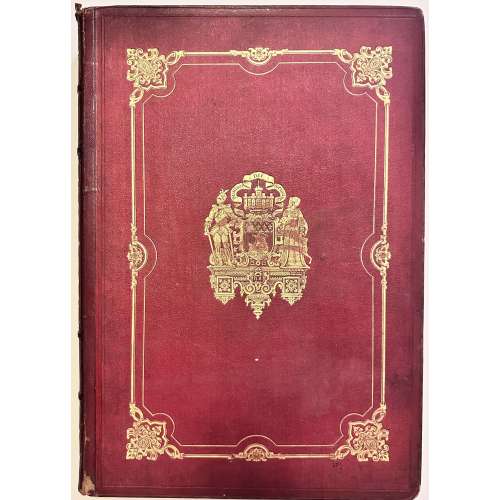 NEWThree volumes, hardcover in-folio, 495 x 350 mm, 1st edition, uniformly bound in red faux-chagrin with gilt coat of arms of the city of Paris in the centre of gild-decorated panel, gilt decorated spine with lettering, marbled endpapers, 3 vol. (122 p.-[46] pl., 76-44-24-22-36-26...); vol. 1 – 340 pp, vol. 2 – 296 pp, vol. 3 – 268 pp ; total 100 leaves of plates. Title-page (red and black): PARIS | DANS SA SPLENDEUR | MONUMENTS, VUES, SCÉNES HISTORIQUES, DESCRIPTIONS ET HISTOIRE | DESSINS ET LITHOGRAPHIES | […] | VIGNETTES DE FÉLIX BENOIST ET CATENACCI, EXÉCUTÉES SUR BOIS PAR LES PREMIERS GRAVURS | TEXTE | […] | Premier Volume (Deuxième Volume, Troisième Volume) | PREMIERE PARTIE. — DESCRIPTION DE PARIS | {vignette} | Publié par | HENRI CHARPENTIER, IMPRIMEUR-ÉDITEUR | PARIS, QUAI DES GRANDS-AUGUSTINS, 55. — ÉTABLESSEMENT A NANTES, RUE DE LA FOSSE. | M. DCCC. LXI. || Contributors: Mérimée, Prosper (French, 1803 – 1870) – text Viollet-le-Duc, Eugène (French, 1814 – 1879) – text Audiganne, Armand (French, 1814 – 1875) – text Philippe Benoist (French, 1813 – 1896) – lithography Benoist, Félix (French, 1818 – 1896) – woodcuts Catenacci, Hercule Louis (French, 1816 – 1884) – woodcuts Charpentier, Henri-Désiré (French, 1806 – 1882) Henri Charpentier imprimeur (Nantes) – printer Henri Charpentier éditeur (Paris) –publisher
NEWThree volumes, hardcover in-folio, 495 x 350 mm, 1st edition, uniformly bound in red faux-chagrin with gilt coat of arms of the city of Paris in the centre of gild-decorated panel, gilt decorated spine with lettering, marbled endpapers, 3 vol. (122 p.-[46] pl., 76-44-24-22-36-26...); vol. 1 – 340 pp, vol. 2 – 296 pp, vol. 3 – 268 pp ; total 100 leaves of plates. Title-page (red and black): PARIS | DANS SA SPLENDEUR | MONUMENTS, VUES, SCÉNES HISTORIQUES, DESCRIPTIONS ET HISTOIRE | DESSINS ET LITHOGRAPHIES | […] | VIGNETTES DE FÉLIX BENOIST ET CATENACCI, EXÉCUTÉES SUR BOIS PAR LES PREMIERS GRAVURS | TEXTE | […] | Premier Volume (Deuxième Volume, Troisième Volume) | PREMIERE PARTIE. — DESCRIPTION DE PARIS | {vignette} | Publié par | HENRI CHARPENTIER, IMPRIMEUR-ÉDITEUR | PARIS, QUAI DES GRANDS-AUGUSTINS, 55. — ÉTABLESSEMENT A NANTES, RUE DE LA FOSSE. | M. DCCC. LXI. || Contributors: Mérimée, Prosper (French, 1803 – 1870) – text Viollet-le-Duc, Eugène (French, 1814 – 1879) – text Audiganne, Armand (French, 1814 – 1875) – text Philippe Benoist (French, 1813 – 1896) – lithography Benoist, Félix (French, 1818 – 1896) – woodcuts Catenacci, Hercule Louis (French, 1816 – 1884) – woodcuts Charpentier, Henri-Désiré (French, 1806 – 1882) Henri Charpentier imprimeur (Nantes) – printer Henri Charpentier éditeur (Paris) –publisher -
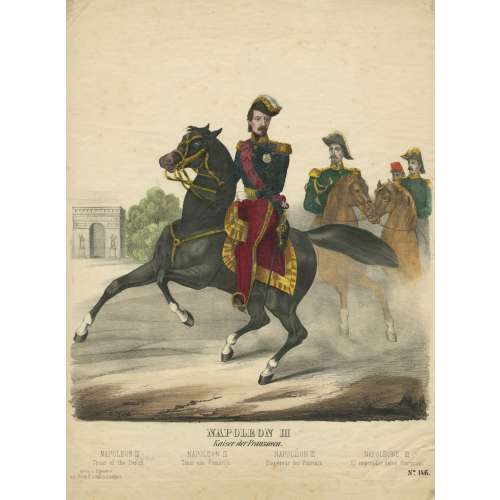 Hand-coloured lithography on wove paper 423 x 332 mm; On reverse: black ink stamp “4956”, ms “A”, ms pencil “428” and “Ernest”. Under the image, centre: "NAPOLEON III | Kaiser der Franzosen." Velow: | NAPOLEON III | Czaar of the French — NAPOLEON III | Czaar van Frankrijk — NAPOLÉON III | Empereur des Francais. — NAPOLEONE III | El emperador delos Franceses; bottom left: "Verlag u. Eigenthum | von. Fried. G. Schulz in Stuttgart.", right: "No 146." The artist's and printer's names in stone are not legible. Published in Stuttgart by Friederich Gustav Schulz (German, 1786 – 1859) during the time of the Second French Empire (1852-1870).
Hand-coloured lithography on wove paper 423 x 332 mm; On reverse: black ink stamp “4956”, ms “A”, ms pencil “428” and “Ernest”. Under the image, centre: "NAPOLEON III | Kaiser der Franzosen." Velow: | NAPOLEON III | Czaar of the French — NAPOLEON III | Czaar van Frankrijk — NAPOLÉON III | Empereur des Francais. — NAPOLEONE III | El emperador delos Franceses; bottom left: "Verlag u. Eigenthum | von. Fried. G. Schulz in Stuttgart.", right: "No 146." The artist's and printer's names in stone are not legible. Published in Stuttgart by Friederich Gustav Schulz (German, 1786 – 1859) during the time of the Second French Empire (1852-1870). -
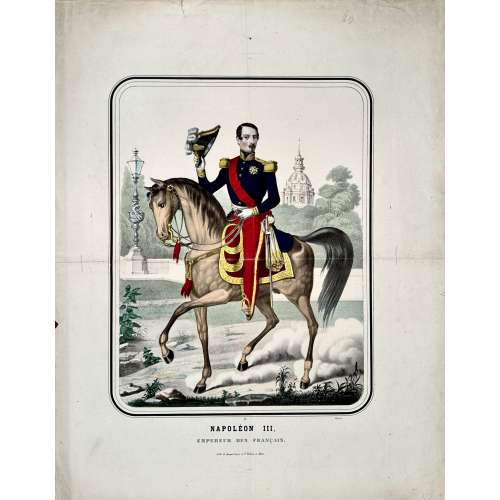 Hand-coloured chromolithography on wove paper, 600 x 470 mm; black ink stamp “4921” to reverse, horizontal and vertical centrefolds. Image of Napoléon III on horseback, in a frame; lettering under the frame: 34 — Déposé | NAPOLÉON III | EMPEREUR DES FRANÇAIS. | Lith. de Gangel frères et P. Didion, à Metz. || Gangel frères et P. Didion (Metz) – printer/publisher. Paulin Didion (French, 1831 – 1879)
Hand-coloured chromolithography on wove paper, 600 x 470 mm; black ink stamp “4921” to reverse, horizontal and vertical centrefolds. Image of Napoléon III on horseback, in a frame; lettering under the frame: 34 — Déposé | NAPOLÉON III | EMPEREUR DES FRANÇAIS. | Lith. de Gangel frères et P. Didion, à Metz. || Gangel frères et P. Didion (Metz) – printer/publisher. Paulin Didion (French, 1831 – 1879) -
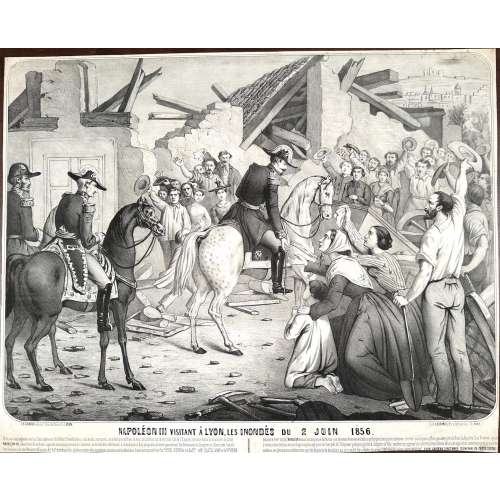 Lithography poster on wove paper, 492 x 614 mm; black ink stamp “5036” to reverse, vertical centerfold. Image in frame; under the frame left: "J. B. Gadola, éditeur. Cours de Brosses 1, à LYON."; right: "Lith LAURANT & Cie r. de Bernardins 34, Paris." Title and text below the image. Jean-Baptiste Gadola (French, 1818 – 1870) – publisher.
Lithography poster on wove paper, 492 x 614 mm; black ink stamp “5036” to reverse, vertical centerfold. Image in frame; under the frame left: "J. B. Gadola, éditeur. Cours de Brosses 1, à LYON."; right: "Lith LAURANT & Cie r. de Bernardins 34, Paris." Title and text below the image. Jean-Baptiste Gadola (French, 1818 – 1870) – publisher. -
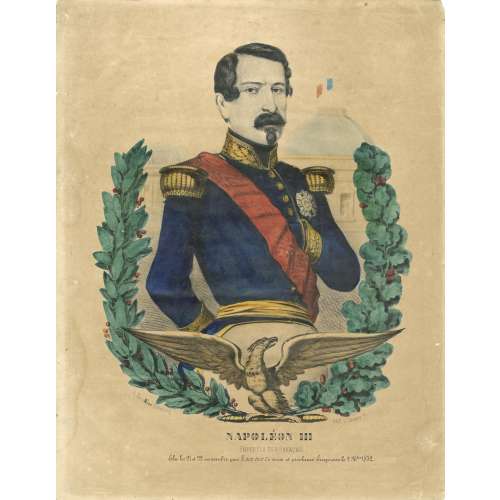 Hand-coloured lithography on wove paper, 380 x 298 mm; black ink stamp “4912” to reverse. On stone left: "A, Paris Miné Éditeur, imp.;" right: "Lith. R. St. Jacques. 41." Bottom center: "Napoléon III"; below: "EMPEREUR DES FRANÇAIS", under: "Élu les 21 el 22 novembre par 8,000,000 de voix et proclamé Empereur le 2 Xbre 1852." Printer/publisher: Miné, éditeur, imprimeur en lithographie, Rue Saint-Jacques, 41. Napoleon III [Charles-Louis Napoléon Bonaparte] (French, 1808 – 1873)
Hand-coloured lithography on wove paper, 380 x 298 mm; black ink stamp “4912” to reverse. On stone left: "A, Paris Miné Éditeur, imp.;" right: "Lith. R. St. Jacques. 41." Bottom center: "Napoléon III"; below: "EMPEREUR DES FRANÇAIS", under: "Élu les 21 el 22 novembre par 8,000,000 de voix et proclamé Empereur le 2 Xbre 1852." Printer/publisher: Miné, éditeur, imprimeur en lithographie, Rue Saint-Jacques, 41. Napoleon III [Charles-Louis Napoléon Bonaparte] (French, 1808 – 1873) -
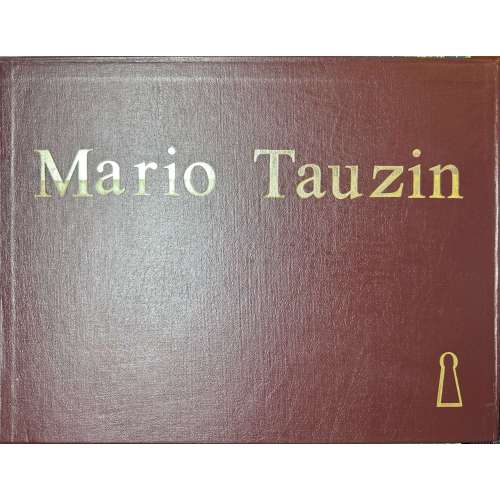 Set of 30 lithographic plates printed on watermarked Van Gelder Simili Japon wove paper, loose in two rexine-backed stiff paper wrappers, 15 in each, together in rexine portfolio with gilt lettering and keyhole on front cover. According to the seller, these are facsimiles of prints/ drawings by Mario Tauzin. Scenes from the series 'Interdit aux adultes'. No publisher indicated; printed in about 1950—a limited edition. Six of these designs used to illustrate 'Bonne à tout faire' were published by Éric Losfeld in the late 1950s (LIB-3293.2024). Dimensions: sheet 320 x 420 mm; album 330 x 430 mm. Contributor: Mario Tauzin (French, 1909 – 1979) — artist
Set of 30 lithographic plates printed on watermarked Van Gelder Simili Japon wove paper, loose in two rexine-backed stiff paper wrappers, 15 in each, together in rexine portfolio with gilt lettering and keyhole on front cover. According to the seller, these are facsimiles of prints/ drawings by Mario Tauzin. Scenes from the series 'Interdit aux adultes'. No publisher indicated; printed in about 1950—a limited edition. Six of these designs used to illustrate 'Bonne à tout faire' were published by Éric Losfeld in the late 1950s (LIB-3293.2024). Dimensions: sheet 320 x 420 mm; album 330 x 430 mm. Contributor: Mario Tauzin (French, 1909 – 1979) — artist -
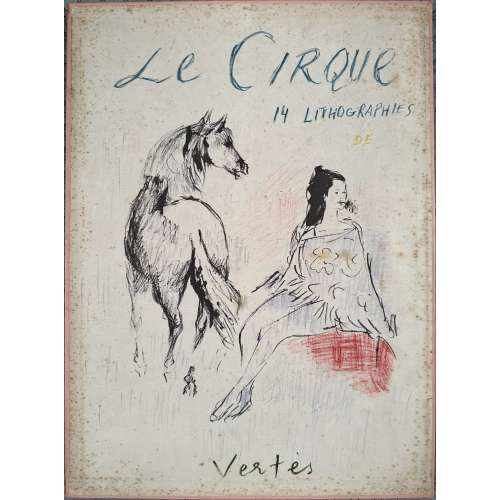 Publisher’s peach cloth box 555 x 410 mm with coloured lithograph on the lid, autographed with crayons "Le Cirque | 14 LITHOGRAPHIES | DE | {vignette} | Vertes"; in-folio unbound 4 pp. booklet on laid paper watermarked “Marais” and 14 loose leaves of plates on laid paper 520 x 395 mm without a watermark with coloured lithographs signed “Vertes” and numbered “195/250” in pencil; interleaved with tracing paper. Box and plates foxed. Title-page (red and black): LE | CIRQUE | 14 LITHOGRAPHIES DE | VERTÈS | PRÉSENTÉ | PAR | JEAN COCTEAU || Imprint: LES LIVES MERVEILLEUX | MONACO | Il a été tiré de cet album : | 150 Exemplaires, | destinés à | l'Amérique, | distribués bar les soins de | Arthur H. Harlow | de New-York, | & | 100 Exemplaires, | réservés à la France. | 15 Avril 1949 || Limitation: Edition limited to 250 copies (150 for USA, 100 for France); this is copy № 195 printed for France as the American copies marked “Published by Arthur H. Harlow & Co., New York. Seller’s Description: VERTÈS, Marcel (Hungarian-French, 1895-1961). Le Cirque 14 Lithographies de Vertès. Présénte par Jean Cocteau. [Monaco: Les Livres Merveilleux, 1949]. [vi] pp. With all 14 lithographs, each signed by the artist and numbered “195/250”. Text and lithographs 15 ¼ x 20 ½”. In original publisher’s peach cloth box with printed label on lid (box foxed, soiled, lightly worn; lithographs and text foxed). Still, a very good example of this lovely collection, with an introduction by Jean Cocteau (1889-1963). Catalogue Raisonné: Vokaer № 50. Marcel Vertès [Marcell Vértes] (Jewish-Hungarian-French, 1895 – 1961) – artist. Arthur H. Harlow (American, c. 1877 – 1958) – publisher. Jean Cocteau (French, 1889 – 1963) – author.
Publisher’s peach cloth box 555 x 410 mm with coloured lithograph on the lid, autographed with crayons "Le Cirque | 14 LITHOGRAPHIES | DE | {vignette} | Vertes"; in-folio unbound 4 pp. booklet on laid paper watermarked “Marais” and 14 loose leaves of plates on laid paper 520 x 395 mm without a watermark with coloured lithographs signed “Vertes” and numbered “195/250” in pencil; interleaved with tracing paper. Box and plates foxed. Title-page (red and black): LE | CIRQUE | 14 LITHOGRAPHIES DE | VERTÈS | PRÉSENTÉ | PAR | JEAN COCTEAU || Imprint: LES LIVES MERVEILLEUX | MONACO | Il a été tiré de cet album : | 150 Exemplaires, | destinés à | l'Amérique, | distribués bar les soins de | Arthur H. Harlow | de New-York, | & | 100 Exemplaires, | réservés à la France. | 15 Avril 1949 || Limitation: Edition limited to 250 copies (150 for USA, 100 for France); this is copy № 195 printed for France as the American copies marked “Published by Arthur H. Harlow & Co., New York. Seller’s Description: VERTÈS, Marcel (Hungarian-French, 1895-1961). Le Cirque 14 Lithographies de Vertès. Présénte par Jean Cocteau. [Monaco: Les Livres Merveilleux, 1949]. [vi] pp. With all 14 lithographs, each signed by the artist and numbered “195/250”. Text and lithographs 15 ¼ x 20 ½”. In original publisher’s peach cloth box with printed label on lid (box foxed, soiled, lightly worn; lithographs and text foxed). Still, a very good example of this lovely collection, with an introduction by Jean Cocteau (1889-1963). Catalogue Raisonné: Vokaer № 50. Marcel Vertès [Marcell Vértes] (Jewish-Hungarian-French, 1895 – 1961) – artist. Arthur H. Harlow (American, c. 1877 – 1958) – publisher. Jean Cocteau (French, 1889 – 1963) – author. -
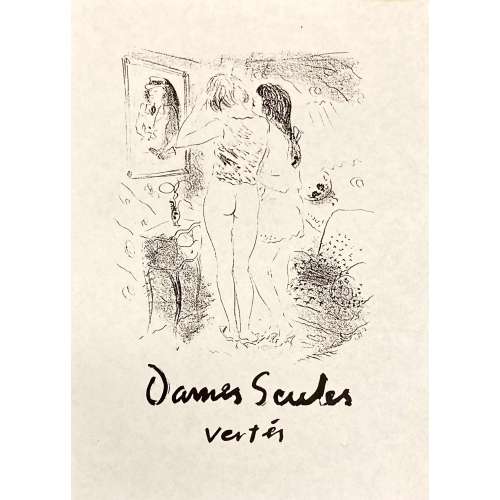 1st edition, limited to 52 copies of which 7 copies on Japon paper (№ 1-7) and 45 copies on Rives paper (№ 8-52); printed by Maurice Daratiere; this copy is № 50. “Ladies only” – a pictorial album, unbound, printed by Maurice Darantiere, with 15 black and white lithographs by Edouard Duchâtel (French, 19th-20th century) after drawings by Marcel Vertès on cream wove paper 38 x 28 cm; French flapped wrappers, with the lithographed manuscript title “Dames seules” in a grey clamshell box 40 x 30 cm; printed by Maurice Darantiere, title with vignette pasted to box cover, one image on a double sheet; all illustrations with tissue guards. Bookplate “From the Library of | Vance Gerry | The Weather Bird Press | pasted inside the box cover (see Vance Gerry and The Weather Bird Press). Provenance: Vance Bryden Gerry (American, 1929 – 2005) Contributors: Marcel Vertès [Marcell Vértes] (Jewish-Hungarian-French, 1895 – 1961) – artist. Francis Carco [François Carcopino-Tusoli] (French, 1886 – 1958) – author. Edouard Duchâtel (French, 19th-20th century) – artist, lithographer. Maurice Darantiere (French, 1882 – 1962) – printer. Louis Godefroy (French, 1885 – 1934) – publisher. Other names: Marcel Vertès, Marcel Vertes, Marcell Vértes
1st edition, limited to 52 copies of which 7 copies on Japon paper (№ 1-7) and 45 copies on Rives paper (№ 8-52); printed by Maurice Daratiere; this copy is № 50. “Ladies only” – a pictorial album, unbound, printed by Maurice Darantiere, with 15 black and white lithographs by Edouard Duchâtel (French, 19th-20th century) after drawings by Marcel Vertès on cream wove paper 38 x 28 cm; French flapped wrappers, with the lithographed manuscript title “Dames seules” in a grey clamshell box 40 x 30 cm; printed by Maurice Darantiere, title with vignette pasted to box cover, one image on a double sheet; all illustrations with tissue guards. Bookplate “From the Library of | Vance Gerry | The Weather Bird Press | pasted inside the box cover (see Vance Gerry and The Weather Bird Press). Provenance: Vance Bryden Gerry (American, 1929 – 2005) Contributors: Marcel Vertès [Marcell Vértes] (Jewish-Hungarian-French, 1895 – 1961) – artist. Francis Carco [François Carcopino-Tusoli] (French, 1886 – 1958) – author. Edouard Duchâtel (French, 19th-20th century) – artist, lithographer. Maurice Darantiere (French, 1882 – 1962) – printer. Louis Godefroy (French, 1885 – 1934) – publisher. Other names: Marcel Vertès, Marcel Vertes, Marcell Vértes -
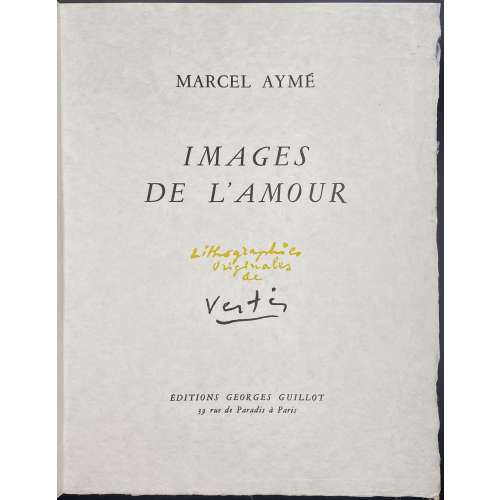 Title-page: MARCEL AYMÉ | IMAGES DE L'AMOUR | Lithographies | originales | de | Vertès (fac-simile ms) | ÉDITIONS GEORGES GUILLOT | 39 rue de Paradis à Paris || French flapped wrapper in a natural canvas double slipcase with gilt lettering to spine, 34.8 x 27.3 cm. Leaves 33 x 25.5 cm, 4 blanks at the beginning, to the second pair of leaves pasted two autograph letters signed by Marcel Aymé; [1-8] 9-119 [120] [6], last leaf blank, h.t. with inscription "En sincère hommage" signed by both Marcel Aymé and Marcel Vertès; 9 full-page chromolithographs, 6 headpieces and 2 tailpieces by Marcel Vertès, tissue-guards; in-4to, unbound. Printed on October 20, 1957. The edition is limited to 190 copies + 25 not for sale, this is copy № 1, printed on Japon Nacré paper and enriched with three additional suites of lithographs: one on Japon Nacré, one on Japon ancien, one on Hollande, plus a set of decomposition of one chromolithograph; lacking three original drawings. Contributors: Marcel Aymé (French, 1902 – 1967) – author. Marcel Vertès [Marcell Vértes] (Jewish-Hungarian-French, 1895 – 1961) – artist. Georges Guillot – publisher. Andrée Koch – designer. Fequet et Baudier – printers, typography. Edmond et Jacques Desjobert – lithographers. Other names: Marcel Vertès, Marcel Vertes, Marcell Vértes
Title-page: MARCEL AYMÉ | IMAGES DE L'AMOUR | Lithographies | originales | de | Vertès (fac-simile ms) | ÉDITIONS GEORGES GUILLOT | 39 rue de Paradis à Paris || French flapped wrapper in a natural canvas double slipcase with gilt lettering to spine, 34.8 x 27.3 cm. Leaves 33 x 25.5 cm, 4 blanks at the beginning, to the second pair of leaves pasted two autograph letters signed by Marcel Aymé; [1-8] 9-119 [120] [6], last leaf blank, h.t. with inscription "En sincère hommage" signed by both Marcel Aymé and Marcel Vertès; 9 full-page chromolithographs, 6 headpieces and 2 tailpieces by Marcel Vertès, tissue-guards; in-4to, unbound. Printed on October 20, 1957. The edition is limited to 190 copies + 25 not for sale, this is copy № 1, printed on Japon Nacré paper and enriched with three additional suites of lithographs: one on Japon Nacré, one on Japon ancien, one on Hollande, plus a set of decomposition of one chromolithograph; lacking three original drawings. Contributors: Marcel Aymé (French, 1902 – 1967) – author. Marcel Vertès [Marcell Vértes] (Jewish-Hungarian-French, 1895 – 1961) – artist. Georges Guillot – publisher. Andrée Koch – designer. Fequet et Baudier – printers, typography. Edmond et Jacques Desjobert – lithographers. Other names: Marcel Vertès, Marcel Vertes, Marcell Vértes
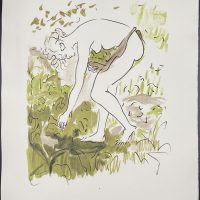


-
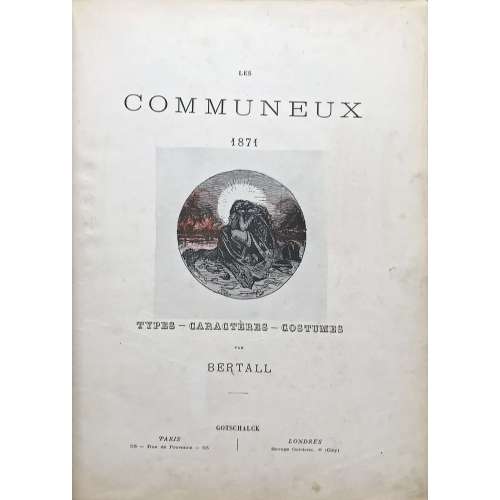 Folio (240 x 320 mm), hardbound in blue-aubergine cloth with gilt lettering and decoration. Album with Avant-Propos and 34 hand-colored lithographs by Bertall, numbered 1 through 34. Details in Russian: "Памяти парижской коммуны".
Folio (240 x 320 mm), hardbound in blue-aubergine cloth with gilt lettering and decoration. Album with Avant-Propos and 34 hand-colored lithographs by Bertall, numbered 1 through 34. Details in Russian: "Памяти парижской коммуны". -
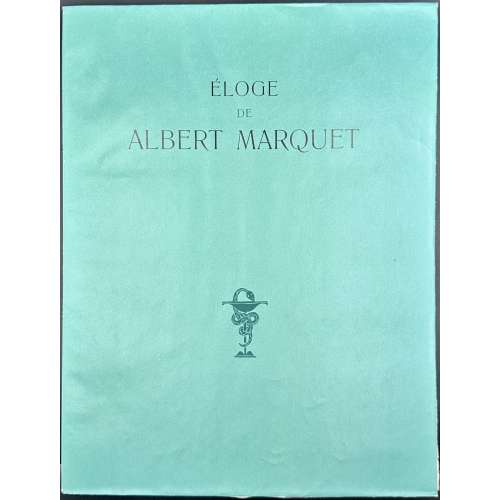 NEWSoftcover, 328 x 250 mm, green French flapped wrappers, lettered; 22 leaves plus 2 in wrappers, unpaginated, incl. frontispiece (etching), headpiece (lithography), 4 in-text illustrations (1 lithography + 3 etchings), and 5 plates (3 dry points + 1 etching = 1 lithography) by Albert Marquet. Limited edition of 200 copies on Arches Vellum, watermarked, of which this is copy № 144; published by Manuel Bruker on May 16, 1948; lithographs printed by André Clot. Title-page (olive and black): ÉLOGE | DE | ALBERT MARQUET | PAR | LÉON WERTH | ORNÉ | DE GRAVURES ORIGINALES | {publisher’s device} | MANUEL BRUKER ÉDITEUR || Colophon: J'AI ACHEVÉ D'IMPRIMER | CET OUVRAGE LE JOUR DE | LA PENTECOTE 1948 A 200 | EXEMPLAIRES SUR VÉLIN | D'ARCHES A LA FORME NU | MÉROTES DE 1 A 200. ON | A JOINT AUX 20 PREMIERS | EXEMPLAIRES UNE SUITE | SUR PAPIER JAPON ANCIEN | ET UNE SUITE DES PLAN | CHES NON UTILISEES. LES | LITHOGRAPHIES ONT ÉTÉ | TIRÉES PAR ANDRÉ CLOT. The day of Pentecost in 1948 was Sunday, May 16. Contributors: Werth, Léon (French, 1878 – 1955) – author Marquet, Albert (French, 1875 – 1947) – artist Bruker, Manuel [Mendel] (Jewish-Hungarian-French, 1891 – 1979) – publisher Clot, André (French, 1909 – 2002) – printer
NEWSoftcover, 328 x 250 mm, green French flapped wrappers, lettered; 22 leaves plus 2 in wrappers, unpaginated, incl. frontispiece (etching), headpiece (lithography), 4 in-text illustrations (1 lithography + 3 etchings), and 5 plates (3 dry points + 1 etching = 1 lithography) by Albert Marquet. Limited edition of 200 copies on Arches Vellum, watermarked, of which this is copy № 144; published by Manuel Bruker on May 16, 1948; lithographs printed by André Clot. Title-page (olive and black): ÉLOGE | DE | ALBERT MARQUET | PAR | LÉON WERTH | ORNÉ | DE GRAVURES ORIGINALES | {publisher’s device} | MANUEL BRUKER ÉDITEUR || Colophon: J'AI ACHEVÉ D'IMPRIMER | CET OUVRAGE LE JOUR DE | LA PENTECOTE 1948 A 200 | EXEMPLAIRES SUR VÉLIN | D'ARCHES A LA FORME NU | MÉROTES DE 1 A 200. ON | A JOINT AUX 20 PREMIERS | EXEMPLAIRES UNE SUITE | SUR PAPIER JAPON ANCIEN | ET UNE SUITE DES PLAN | CHES NON UTILISEES. LES | LITHOGRAPHIES ONT ÉTÉ | TIRÉES PAR ANDRÉ CLOT. The day of Pentecost in 1948 was Sunday, May 16. Contributors: Werth, Léon (French, 1878 – 1955) – author Marquet, Albert (French, 1875 – 1947) – artist Bruker, Manuel [Mendel] (Jewish-Hungarian-French, 1891 – 1979) – publisher Clot, André (French, 1909 – 2002) – printer -
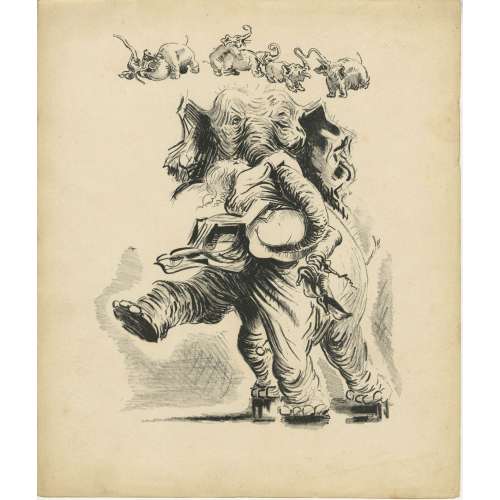
Album of 20 hand-coloured lithographs with a title page and a 'justification du tirage' page in an original snakeskin-clothed cardboard binder. Drawn on stone by Anonymous, attributed to Santippa. The theme of these pictures can be described as erotic humour.
Edition: 200 copies printed in Bruxelles, c. 1938; this copy without a number.
Watermarked wove paper: Word "Marais" and a flower.
Dimensions: 24.3 x 29.3 cm According to J.-P. Dutel, the author of these images is Georges Hoffmann under the pseudonym Santippa. Honesterotica provides a different name: Gaston Hoffmann [Santippa] (French, 1883 – 1977), which seems adequate. Catalogue raisonné: Dutel (1920-70): 2496. -
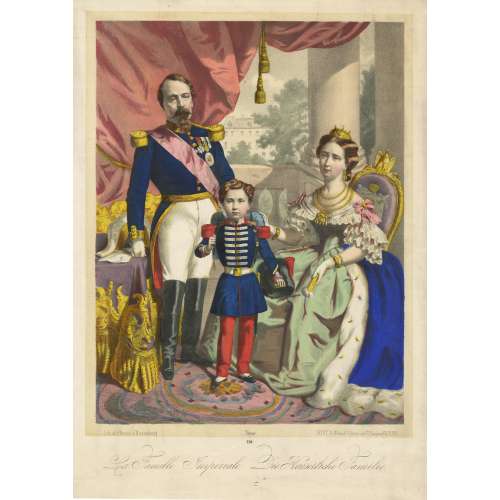 Hand-coloured lithography on wove paper, 395 x 280 mm; black ink stamp “5309” to reverse. On image: artist's initials "L. H."; on stone: "Lith. de Fr. Wentzel a Wissembourg. — Déposé — DÉPÔT, Fr. Wentzel Editeur rue St. Jacques 65, PARIS"; below centre: "239"; bottom : La famille Impériale. Die Kaizerliche Familie. Napoleon III [Charles-Louis Napoléon Bonaparte] (French, 1808 – 1873) Eugénie de Montijo [L'impératrice Eugénie] (Spanish-French, 1826 – 1920) Napoléon, Prince Imperial (Napoléon Eugène Louis Jean Joseph Bonaparte] (French, 1856 – 1879) Jean Frédéric Wentzel (French, 1807 – 1869) – publisher/printer.
Hand-coloured lithography on wove paper, 395 x 280 mm; black ink stamp “5309” to reverse. On image: artist's initials "L. H."; on stone: "Lith. de Fr. Wentzel a Wissembourg. — Déposé — DÉPÔT, Fr. Wentzel Editeur rue St. Jacques 65, PARIS"; below centre: "239"; bottom : La famille Impériale. Die Kaizerliche Familie. Napoleon III [Charles-Louis Napoléon Bonaparte] (French, 1808 – 1873) Eugénie de Montijo [L'impératrice Eugénie] (Spanish-French, 1826 – 1920) Napoléon, Prince Imperial (Napoléon Eugène Louis Jean Joseph Bonaparte] (French, 1856 – 1879) Jean Frédéric Wentzel (French, 1807 – 1869) – publisher/printer. -
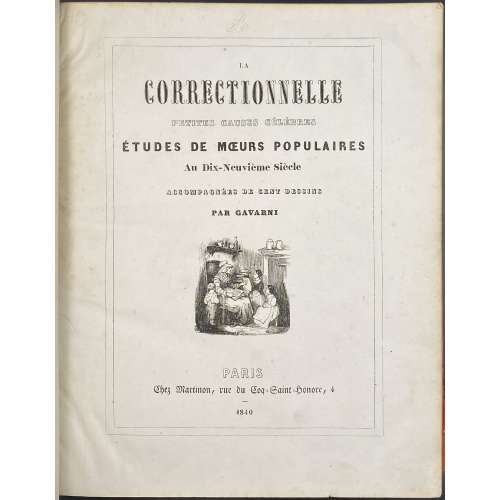 Title-page: LA | CORRECTIONNELLE | PETITES CAUSES CÉLÈBRES | ÉTUDES DE MŒURS POPULAIRES | Au Dix-Neuvième Siècle | ACCOMPAGNÉES DE CENT DESSINS | PAR GAVARNI | {woodcut vignette} | PARIS | Chez Martinon, rue du Coq-Saint-Honoré, 4 | 1840 || Collation: 2o, π3 (t.p. (wrapper?), h.t., t.p.), 1-1012; 205 leaves total, of them 100 plates, lithographs by Gavarni. Pagination: [6] [1] 2-403 [404], 410 pages total, incl. ils. (BnF calls for 426 pages total). Note: plate № 8 is numbered 9, plate № 9 numbered 8; p. 266 numbered 264, p. 268 numbered 266, p. 362 numbered 374, p. 364 numbered 376 (as called for by Carteret). Binding: “Romantique” publisher's quarter calf with gilt lettering and design elements over red paper boards, marbled endpapers. Complete 100 issues of the 4-page “La Correctionnelle” with a woodcut vignette after Gavarni on the 1st page of each issue, published between December 1839 and December 1840, and collected under one cover in 1840 by Martinon. Catalogue raisonné: Carteret (Le trésor, 1927): pp. 177-8; Brivois (1883): p.112. Both authors marked the edition as «rare in good condition". Gavarni [Sulpice Guillaume Chevalier] (French, 1804 – 1866) – artist. Amedée Gratiot et Cie. – printer, text. Coulon et Cie.– printer, lithographs. Coulon, Barthélémy Henry (French, fl. 1839 – ?)
Title-page: LA | CORRECTIONNELLE | PETITES CAUSES CÉLÈBRES | ÉTUDES DE MŒURS POPULAIRES | Au Dix-Neuvième Siècle | ACCOMPAGNÉES DE CENT DESSINS | PAR GAVARNI | {woodcut vignette} | PARIS | Chez Martinon, rue du Coq-Saint-Honoré, 4 | 1840 || Collation: 2o, π3 (t.p. (wrapper?), h.t., t.p.), 1-1012; 205 leaves total, of them 100 plates, lithographs by Gavarni. Pagination: [6] [1] 2-403 [404], 410 pages total, incl. ils. (BnF calls for 426 pages total). Note: plate № 8 is numbered 9, plate № 9 numbered 8; p. 266 numbered 264, p. 268 numbered 266, p. 362 numbered 374, p. 364 numbered 376 (as called for by Carteret). Binding: “Romantique” publisher's quarter calf with gilt lettering and design elements over red paper boards, marbled endpapers. Complete 100 issues of the 4-page “La Correctionnelle” with a woodcut vignette after Gavarni on the 1st page of each issue, published between December 1839 and December 1840, and collected under one cover in 1840 by Martinon. Catalogue raisonné: Carteret (Le trésor, 1927): pp. 177-8; Brivois (1883): p.112. Both authors marked the edition as «rare in good condition". Gavarni [Sulpice Guillaume Chevalier] (French, 1804 – 1866) – artist. Amedée Gratiot et Cie. – printer, text. Coulon et Cie.– printer, lithographs. Coulon, Barthélémy Henry (French, fl. 1839 – ?) -
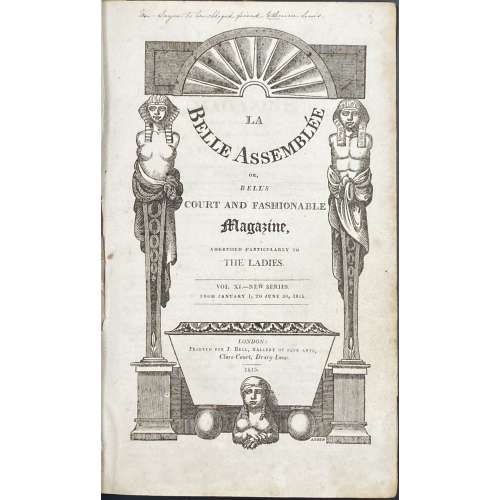 Title: LA | BELLE ASSEMBLÉE | OR, | BELL'S | COURT AND FASHIONABLE | MAGAZINE, | ADDRESSED PARTICULARLY TO | THE LADIES. | VOL. XI.—NEW SERIES. | FROM JANUARY 1, TO JUNE 30, 1815. | LONDON: | Printed for J. BELL, GALLERY OF FINE ARTS, | Clare-Court, Drury-Lane. | 1815. || Pagination: [2] – 11th volume wood-engraved pictorial title page, [1, 2] – January faux-title and table of content, [3] 4-284 [2] – index to 11th vol. Notes: February f.t. not paginated, but within the collation; the last page of the index at the very end paginated [iii]/iv, so pages i/ii missing (the gathering Nn lacking one sheet) Collation: 4to; π1 A-Mm4 Nn3, 28 plates extraneous to collation (lacking 2 plates). Binding: Half brown morocco over marbled boards, flat spine, compartments gilt-ruled with double-fillet and gilt-lettered. Contents: Jan: pp. 1-48, 5 plates. Feb: pp. 51-96, 5 plates. Mar: pp. 97-144, 5 plates. Apr: pp. 145-192, 5 plates. May: pp. 193-240, 5 plates. Jun: pp. 241-284, 3 plates (lacking 2 colour prints). Fashion plates, two per issue, are hand-coloured copperplate engravings, unsigned. Stipple engraved portraits, one per issue as frontispiece: (1) Actress Catherine Stephens, Countess of Essex (British, 1794 – 1882) by James Hopwood the Elder [James Hopwood Senior] (British, c. 1740s/50s – 1819) after Sir George Hayter (British, 1792 – 1871); (2) Madame de Talleyrand, Princesse De Bénévent (Danish-French, 1761– 1834), unsigned, but can be attributed to François Gérard (French, 1770 – 1837); (3) Actress Miss Sarah Booth (1793 – 30 December 1867), unsigned; (4) Group portrait of the French Royal family (Louis XVI, Louis XVII, Marie Antoinette, Madam Elizabeth, Louis Antoine de Bourbon, Duke d'Enghien, and Marie Thérèse Louise of Savoy, Princesse de Lamballe), unsigned, (5) Actress, Miss Sarah Blanche Matthews (b.1794) by Thomas Burke (Irish, 1749 – 1815) after George Hayter. The sixth print, in the March issue, is a lithographic portrait of Napoléon Bonaparte (French, 1769 – 1821), unsigned.
Title: LA | BELLE ASSEMBLÉE | OR, | BELL'S | COURT AND FASHIONABLE | MAGAZINE, | ADDRESSED PARTICULARLY TO | THE LADIES. | VOL. XI.—NEW SERIES. | FROM JANUARY 1, TO JUNE 30, 1815. | LONDON: | Printed for J. BELL, GALLERY OF FINE ARTS, | Clare-Court, Drury-Lane. | 1815. || Pagination: [2] – 11th volume wood-engraved pictorial title page, [1, 2] – January faux-title and table of content, [3] 4-284 [2] – index to 11th vol. Notes: February f.t. not paginated, but within the collation; the last page of the index at the very end paginated [iii]/iv, so pages i/ii missing (the gathering Nn lacking one sheet) Collation: 4to; π1 A-Mm4 Nn3, 28 plates extraneous to collation (lacking 2 plates). Binding: Half brown morocco over marbled boards, flat spine, compartments gilt-ruled with double-fillet and gilt-lettered. Contents: Jan: pp. 1-48, 5 plates. Feb: pp. 51-96, 5 plates. Mar: pp. 97-144, 5 plates. Apr: pp. 145-192, 5 plates. May: pp. 193-240, 5 plates. Jun: pp. 241-284, 3 plates (lacking 2 colour prints). Fashion plates, two per issue, are hand-coloured copperplate engravings, unsigned. Stipple engraved portraits, one per issue as frontispiece: (1) Actress Catherine Stephens, Countess of Essex (British, 1794 – 1882) by James Hopwood the Elder [James Hopwood Senior] (British, c. 1740s/50s – 1819) after Sir George Hayter (British, 1792 – 1871); (2) Madame de Talleyrand, Princesse De Bénévent (Danish-French, 1761– 1834), unsigned, but can be attributed to François Gérard (French, 1770 – 1837); (3) Actress Miss Sarah Booth (1793 – 30 December 1867), unsigned; (4) Group portrait of the French Royal family (Louis XVI, Louis XVII, Marie Antoinette, Madam Elizabeth, Louis Antoine de Bourbon, Duke d'Enghien, and Marie Thérèse Louise of Savoy, Princesse de Lamballe), unsigned, (5) Actress, Miss Sarah Blanche Matthews (b.1794) by Thomas Burke (Irish, 1749 – 1815) after George Hayter. The sixth print, in the March issue, is a lithographic portrait of Napoléon Bonaparte (French, 1769 – 1821), unsigned. -
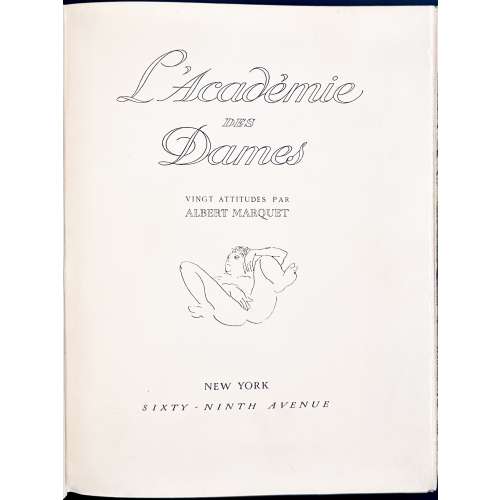 NEWHardcover, 330 x 255 mm, marble paper, two labels of black calf with gilt lettering to spine, 2 blank leaves at front and 2 at back (laid paper), two leaves of lithographic vignettes (t.p. and limitation), plus 20 lithographic plates signed “am”, unpaginated. Limited edition of 25 copies on Japon Impérial paper №№ 1-25, 300 copies on Vélin d’Arches №№ 26-325, of which this is copy № 206. Stones sanded. A poem by Verlaine at p. 2 recto. Title-page: L'Académie | DES | Dames | VINGT ATTITUDES PAR | ALBERT MARQUET | {vignette} | NEW YORK | SIXTY-NINTH AVENUE || Imprint: ÉDITION PRIVÉE | EXEMPLAIRE NUMERO 206 Limitation: JUSTIFICATION DU TIRAGE | IL A ÉTÉ TIRÉ DE CET OUVRAGE | VINGT-CINQ EXEMPLAIRES SUR JAPON IMPÉRIAL | NUMÉROTÉS DE 1 à 25 | ET TROIS CENTS EXEMPLAIRES SUR VÉLIN D'ARCHES | NUMÉROTÉS DE 26 à 325 | PIERRES BIFFÉES || Catalogue raisonné: Dutel III № 949; Nordmann I № 255. Provenance: From the collection of Hans-Jürgen Döpp, Frankfurt. Contributors: Albert Marquet (French, 1875 – 1947) Verlaine, Paul (French, 1844 – 1896) One additional lithographic plate by Marquet from a different source but on a similar subject is laid in.
NEWHardcover, 330 x 255 mm, marble paper, two labels of black calf with gilt lettering to spine, 2 blank leaves at front and 2 at back (laid paper), two leaves of lithographic vignettes (t.p. and limitation), plus 20 lithographic plates signed “am”, unpaginated. Limited edition of 25 copies on Japon Impérial paper №№ 1-25, 300 copies on Vélin d’Arches №№ 26-325, of which this is copy № 206. Stones sanded. A poem by Verlaine at p. 2 recto. Title-page: L'Académie | DES | Dames | VINGT ATTITUDES PAR | ALBERT MARQUET | {vignette} | NEW YORK | SIXTY-NINTH AVENUE || Imprint: ÉDITION PRIVÉE | EXEMPLAIRE NUMERO 206 Limitation: JUSTIFICATION DU TIRAGE | IL A ÉTÉ TIRÉ DE CET OUVRAGE | VINGT-CINQ EXEMPLAIRES SUR JAPON IMPÉRIAL | NUMÉROTÉS DE 1 à 25 | ET TROIS CENTS EXEMPLAIRES SUR VÉLIN D'ARCHES | NUMÉROTÉS DE 26 à 325 | PIERRES BIFFÉES || Catalogue raisonné: Dutel III № 949; Nordmann I № 255. Provenance: From the collection of Hans-Jürgen Döpp, Frankfurt. Contributors: Albert Marquet (French, 1875 – 1947) Verlaine, Paul (French, 1844 – 1896) One additional lithographic plate by Marquet from a different source but on a similar subject is laid in.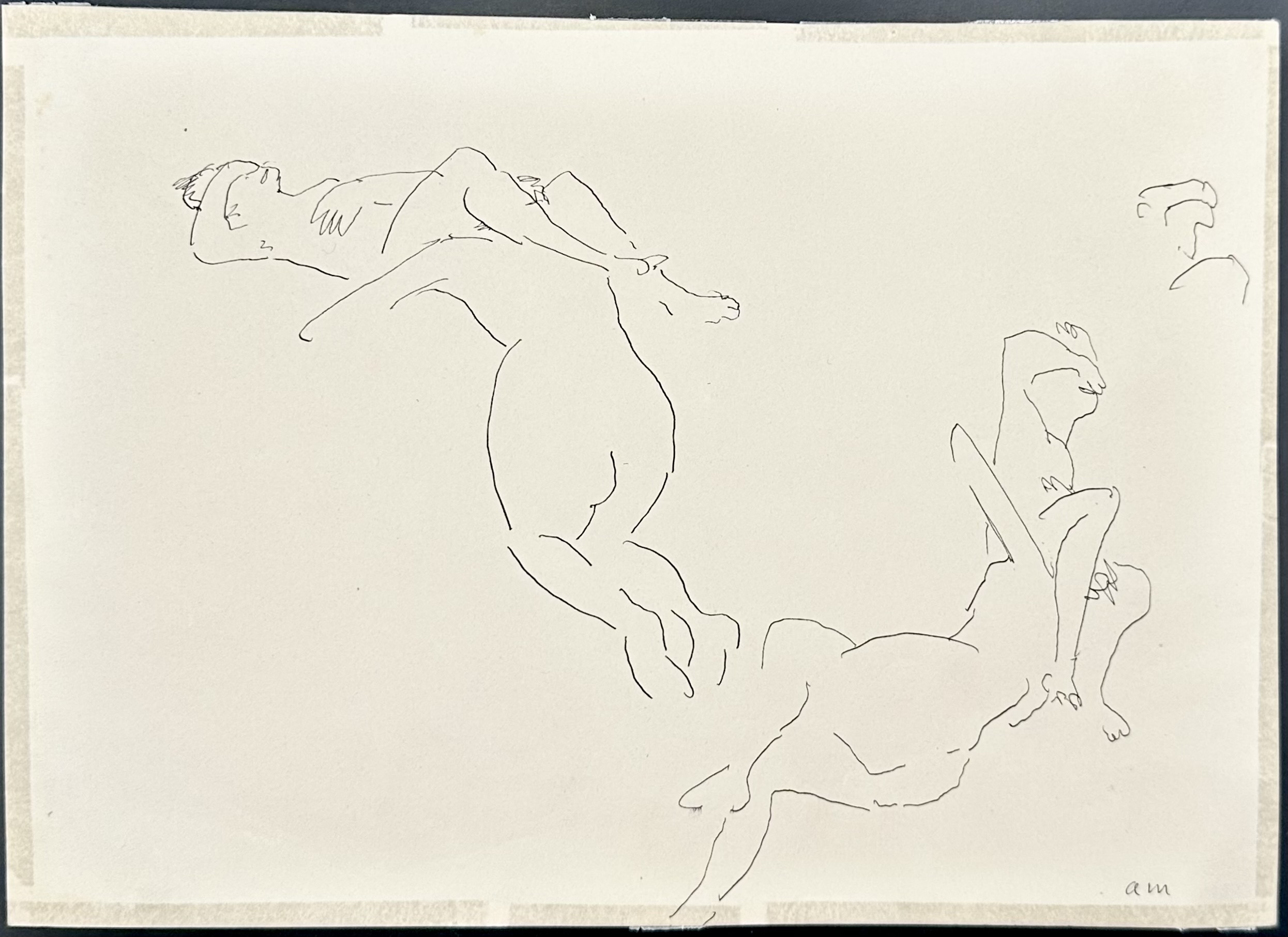
-
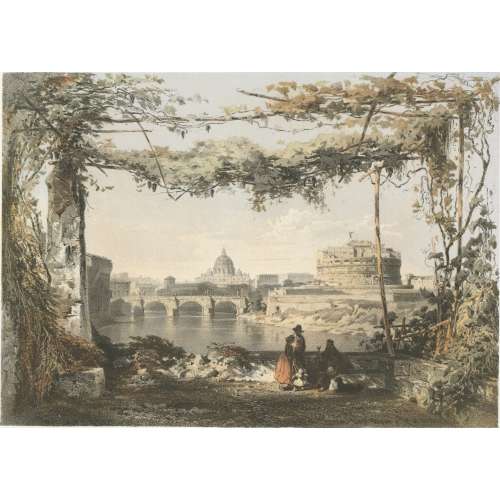
Sheet № 20 from the series of 42 сhromolithography prints 'Skizzen und Bilder aus ROM und der Umgegend' (Sketches and pictures from Rome and surroundings).
Inscriptions:
Top left: LINDEMANN-FROMMEL’S Top right: Skizzen und Bilder aus ROM und der Umgegend. Centre below: No 20 | IL CASTEL E IL PONTE SANT ANGELO, | E SAN PIETRO. Bottom left: Imp. de JACOMME et Cie. R. de Lancry, 16 Paris. Bottom centre: Stuttgart, bei FRANZ KÖHLER. Bottom right: Paris, Goupil et Cie. Editeurs.Dimensions:
Plate: 372 x 473 mm Sheet: 372 x 473 mm
Contributors:
Lindemann-Frommel, Karl (French-German, 1819 – 1891) – artist. Jacomme, Claude (French, fl. 1838 – 1857) – printer/lithographer. Goupil et Cie (Paris); Goupil, Adophe (French, 1806 – 1893) – publisher Franz Köhler (Stuttgart); Köhler, Franz (German, 1805 – 1872) – publisher.


